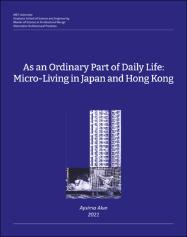Please use this identifier to cite or link to this item:
https://hdl.handle.net/20.500.11779/2070Full metadata record
| DC Field | Value | Language |
|---|---|---|
| dc.contributor.advisor | İnceoğlu, Ahmet Arda | - |
| dc.contributor.advisor | Özgan, Si̇bel Yasemi̇n | - |
| dc.contributor.author | Yavaş, Eda | - |
| dc.date.accessioned | 2023-11-07T05:53:47Z | - |
| dc.date.available | 2023-11-07T05:53:47Z | - |
| dc.date.issued | 2021 | - |
| dc.identifier.citation | Yavaş, E. (2021). The habitats of neonomads: Exploring neonomadic lifestyle through today's dynamics and nomadic codes = Neo göçebe habitatlar: Güncel dinamikler ve göçebe kodlar üzerinden neo-göçebe yaşam, MEF Üniversitesi, Fen Bilimleri Enstitüsü, Mimarlık Ana Bilim Dalı, ss. 1-109 | en_US |
| dc.identifier.uri | https://tez.yok.gov.tr/UlusalTezMerkezi/TezGoster?key=nLNfCsWgUluh5T2iyudShg7gwHubgKk3ec_mlKuRiuAiZV3-W3KZDmke8utW2TSV | - |
| dc.identifier.uri | https://hdl.handle.net/20.500.11779/2070 | - |
| dc.description.abstract | Bugün her zamankinden daha hareketliyiz. Şehirler, ülkeler ve hatta kıtalar arasında hareket etmek veya çevrimiçi platformlar aracılığıyla mekanın fiziksel sınırlarını aşmak daha pratik ve yaygın hale geldi. Bireysel hareketlilik arttı, sınırlar bulanıklaştı ve mekandan bağımsız yaşama arzusu yaygınlaştı. Bilinçli olarak mobil yaşamı tercih eden insanlar, yeni çağın dinamik güçleriyle daha sürdürülebilir ve anlamlı ilişkiler kurduklarını düşünmektedir. Evlerini sırtında taşıyan sırt çantalı gezginler, dijital ekranlarıyla hem çalışan hem de seyahat eden dijital göçebeler ve gönüllü olarak göçebe hayatı benimseyen küresel göçebeler tam zamanlı mobil bir hayat sürmektedirler. Çağın dinamik, geçici ve istikrarsız ortamında, ana akım mimari nesnelerin kararlılık ve kalıcılık varsayımları, yukarıda anlatılan esnek ve hareketli yaşamlarla örtüşmemektedir. Ancak geleceğin ipuçlarını takip eden ve neo-göçebe yaşamın beklentilerini önemseyen mekanlar son yıllarda alternatif olarak öne çıkıyor. Bu tartışmanın odağı, günümüzde giderek yaygınlaşan neo-göçebe yaşam tarzının tanımladığı hareketli ve geçici ilişkiler doğrultusunda, neogöçebelerin günlük alışkanlıklarına ve mekan kullanımlarınına mimarlık çerçevesinden bakmaktır. Göçebe deneyim üzerinden yürütülen araştırmada, geçmiş göçebe kodlarımızın ve 1960'ların göçebe gelecek vizyonlarının izleri sürülerek karşılaştırmalı bir sorgulama yapılmıştır. Dijital göçebeler, küresel göçebeler ve sırt çantalı gezginler ile yarı yapılandırılmış görüşmeler yoluyla veriler toplanarak günlük alışkanlıkları, kullandıkları yerler ve şehirden beklentileri hakkındaki teorik varsayımlar analiz edilmiştir. Neogöçebe yaşam tarzı hangi mimari kavramlara odaklanan mekanları tanımlar? Neogöçebelerin mekan ve şehir ölçeğinde beklentileri, yerleşik insanlarınkinden gerçekten farklı mıdır? Neogöçebelerin eski göçebe kodlarla ilişkisinin izleri sürülebilir mi? | en_US |
| dc.description.abstract | Today we are more mobile than ever. It has become more practical and common to move between cities, countries and even continents, or to cross the physical boundaries of space through online platforms. Individual mobility increased, boundaries blurred, and the desire to live independently of space became widespread. People who consciously prefer mobile life think that they establish more sustainable and meaningful relationships with the dynamic forces of the new age. Backpackers carrying their homes on their backs, digital nomads who both work and travel with their digital screens, and global nomads who voluntarily adopt a nomadic life lead a full-time mobile life. In the dynamic, temporary and unstable environment of the age, the stability and permanence assumptions of mainstream architectural objects do not coincide with the flexible and mobile lives described above. However, places that follow the clues of the future and care about the expectations of neo-nomadic life have come to the fore as an alternative in recent years. The focus of this dissertation is to look at the daily habits and use of space of neo-nomads from the perspective of architecture, in line with the dynamic and temporary relations defined by the neo-nomadic lifestyle, which is becoming increasingly widespread today. In the research conducted on the nomadic experience, a comparative inquiry was made by tracing our past nomadic codes and the nomadic future visions of the 1960s. Data were collected through semi-structured interviews with digital nomads, global nomads, and backpackers to analyze theoretical assumptions about their daily habits, places they use, and expectations from the city. What architectural concepts does the neonomadic lifestyle define spaces that focus on? Are neonomads' expectations at the spatial and urban scale really different from those of settled people? Can the relationship of neonomads with ancient nomadic codes be traced? | en_US |
| dc.language.iso | en | en_US |
| dc.publisher | MEF Üniversitesi | en_US |
| dc.rights | info:eu-repo/semantics/openAccess | en_US |
| dc.subject | Mimarlık | en_US |
| dc.subject | Architecture | en_US |
| dc.title | The Habitats of Neonomads: Exploring Neonomadic Lifestyle Through Today's Dynamics and Nomadic Codes | en_US |
| dc.title.alternative | Neo göçebe habitatlar: Güncel dinamikler ve göçebe kodlar üzerinden neo-göçebe yaşam | en_US |
| dc.type | Master Thesis | en_US |
| dc.authorid | Eda Yavaş / 0000-0001-8576-0495 | - |
| dc.identifier.yoktezid | 825283 | en_US |
| dc.relation.publicationcategory | Tez | en_US |
| dc.identifier.endpage | 109 | en_US |
| dc.identifier.startpage | 1 | en_US |
| dc.department | MEF Üniversitesi, Fen Bilimleri Enstitüsü, Mimarlık Ana Bilim Dalı | en_US |
| dc.institutionauthor | Yavaş, Eda | - |
| item.fulltext | With Fulltext | - |
| item.languageiso639-1 | en | - |
| item.grantfulltext | open | - |
| item.openairecristype | http://purl.org/coar/resource_type/c_18cf | - |
| item.openairetype | Master Thesis | - |
| item.cerifentitytype | Publications | - |
| Appears in Collections: | FBE, Yüksek Lisans - Tez Koleksiyonu | |
Files in This Item:
| File | Description | Size | Format | |
|---|---|---|---|---|
| The habitats of neonomads Exploring neonomadic lifestyle through today's dynamics and nomadic codes.pdf | Tez Dosyası | 23.79 MB | Adobe PDF |  View/Open |
CORE Recommender
Items in GCRIS Repository are protected by copyright, with all rights reserved, unless otherwise indicated.